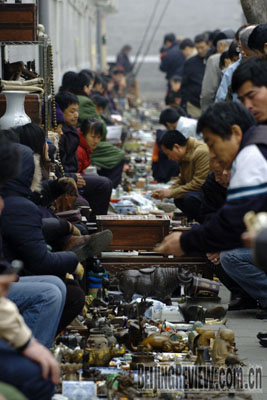|
|

|
|
TREASURE CHEST: Collectors trade their wares in Panjiayuan, a large flea market in Beijing |
Serial painting books are also a hot collection item. In the middle of last century, serial painting books were a widely circulated popular art publication that included comic cartoons and other topics. The largest reader group was children. Its readership shrank sharply in the 1980s and remained small for quite some time. Early this century, as collectors became passionate about serial painting books, its artistic and historical value has been reassessed.
Nostalgia for one's childhood has in some sense fueled the rush for serial painting. Cui Yongyuan, a famous talk show host on China Central Television, explained his love for serial painting books on his program. They were his spiritual food. During the Cultural Revolution, after Cui's mother was condemned as "anti-revolutionary," the children in the neighborhood shunned Cui. Serial painting books were the bait that Cui used to tempt children to play with him. By promising to give a book to anyone who played with him, Cui successfully converted more than 60 children into his playmates. Now, Cui has a collection of hundreds of serial painting books. He also has several friends that are also fanatic about such books.
Research vital
Among the collectors are real art lovers, as well as speculators who want quick money from collecting. Some people see collecting as a good investment. They spot items with huge potential for appreciation, buy and store them until the right time to cash in. Collectors then reinvest the money. Over time, the size of collections increases along with the profit.
A significant number of collectors blindly follow others, without adequate knowledge of history, arts and other relevant fields, so this group is vulnerable to cheating, according to Bai Ming, a renowned porcelain connoisseur.
Ye Peilan, a porcelain expert with more than four decades of research experience in the Palace Museum, thought it was quite unusual for a transitional economy like China to have such a large number of collectors. Ye warned rookie collectors that they must learn the ropes of the trade first.
Amateur collectors face considerable risk of picking up fakes because of a shortage of reliable appraisal services. Although a national cultural relics appraisal committee was set up in China in 1986, the committee only appraised cultural relics unearthed or collected by the government. The committee does not offer commercial appraisal services to society. There are some privately run cultural relics appraisal organizations, whose credentials may not be as good as the ones run by the government.
Private museums
With the reform and opening-up policy, private economy and private property are recognized and protected, which encourages growth of private collections. Some collectors have so many personal items and become so wealthy that they have opened private museums. The early private museums were first seen in large cities like Shanghai, and were often housed in the owners' home. As most of the collections were not cultural relics, the owners usually did not apply to the cultural department of the government for approval, according to Li Wenchang, an editor at Weekly of China's Cultural Relics. A few did get approval from relevant government agencies. As of 1996, the Beijing Cultural Relics Bureau had approved four private museums to be established.
The Law on the Protection of Cultural Relics went into force in 2002, and the law stipulates that citizens can exchange or transfer their legally owned private collections. The law has spurred the growth of private collection and private museums. | 